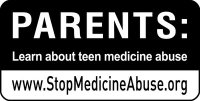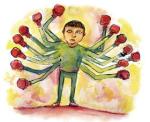I was asked by caring parents and individuals to give people encouraging news. StopMedicineAbuse is making a difference in creating awareness in parents and helping open up the lines of communication with their teens and tweens today.
Although almost two-thirds parents have talked to their teens about cough medicine abuse, a large number still have not had this critical conversation. To help alert these parents, many OTC cough medicines will now feature the Stop Medicine Abuse educational icon on the packaging. The icon, which also can be viewed online (see below), is a key reminder for parents that teen medicine abuse is an issue that they need to be aware of. Here’s what it looks like, so you can keep your eyes peeled:

Look for them on Facebook and join their Fan Club Group to stay updated.
How can you help?
More Parents Talking with Their Teens about Cough Medicine Abuse
Posted by Five Mom, Christy Crandell , on Monday, May 11, 2009
Our efforts to educate parents about medicine abuse have reached thousands of families in the United States. With your help, more parents than ever are learning about this risky teen substance abuse behavior and are talking with their teens. According to the Partnership Attitude Tracking Study, released by the Partnership for a Drug-Free America, 65 percent of parents have talked to their teens about the dangers of abusing OTC cold and cough medicine to get high-an 18 percent increase in the number of parents who talked to their teens in 2007.
My fellow Five Moms and I are excited to share this promising news with you, but there is still much work ahead. Although nearly two-thirds of parents have talked with their teens, 35 percent of parents said that they have not had this important conversation.
We know that when parents talk to their teens about the risks of substance abuse, their teens are up to fifty percent less likely to abuse substances. If you have not already talked with your teens about the dangers of cough medicine abuse, visit our talk page for some helpful ideas on how to have this discussion.
It is also critical that we share this information with our friends and communities as well. Too many parents are still unaware that some teens are abusing OTC cough medicine to get high, and it is important that we talk with them about this behavior. By talking with other parents, we can make sure that every family has the knowledge and tools to help keep teens safe and healthy.
Sharing information about cough medicine abuse is easy. It only takes a moment to start a conversation, and thanks to Stop Medicine Abuse, you can Tell-A-Friend through e-mail or post the Stop Medicine Abuse widget to your blog or web site. The more parents are aware of cough medicine abuse, the better we can prevent this behavior from happening in our communities.
Have you talked with other parents about cough medicine abuse? Share your advice about having this conversation at the Stop Medicine Abuse Fan page
 The Choking Game
The Choking Game  Source:
Source:  TEENSHEALTH
TEENSHEALTH As a mom of an ADHD son, I remember the adolescent years – they were not always the easiest. ADDitude Magazine has some great parenting tips, ideas and answers to help parents today. Years ago I don’t recall as much information was available to us.
As a mom of an ADHD son, I remember the adolescent years – they were not always the easiest. ADDitude Magazine has some great parenting tips, ideas and answers to help parents today. Years ago I don’t recall as much information was available to us.  As the new year has started, parents need to become more educated and informed about today’s teens and the issues they face.
As the new year has started, parents need to become more educated and informed about today’s teens and the issues they face. As the holidays are here, parents should be aware of their teens and tweens concerns with
As the holidays are here, parents should be aware of their teens and tweens concerns with